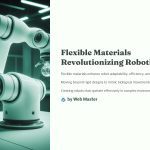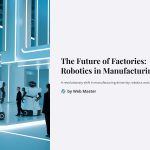

 As robotics and AI continue to evolve, the manufacturing industry is experiencing a revolutionary shift. Factories of the future will be driven by intelligent automation, minimizing human intervention while maximizing efficiency, precision, and productivity. This shift is not just about replacing human workers but about augmenting capabilities to create safer and more sustainable production environments.
As robotics and AI continue to evolve, the manufacturing industry is experiencing a revolutionary shift. Factories of the future will be driven by intelligent automation, minimizing human intervention while maximizing efficiency, precision, and productivity. This shift is not just about replacing human workers but about augmenting capabilities to create safer and more sustainable production environments.

The Rise of Smart Factories
Smart factories leverage AI-driven robots, IoT (Internet of Things), and big data analytics to enhance manufacturing processes. These systems communicate in real time, enabling predictive maintenance, self-optimization, and seamless supply chain management. Companies like Tesla and Siemens are pioneering this approach, using autonomous robots to perform complex tasks with minimal error.
Unlike traditional factories, smart factories can quickly adapt to changing demands, reducing downtime and increasing operational efficiency. The integration of AI-powered robots ensures precision in production, reducing material waste and operational costs.

AI-Powered Automation in Manufacturing
AI-driven robots are becoming an integral part of modern manufacturing. These systems analyze vast amounts of data to make autonomous decisions, optimizing workflow and reducing human error. Key applications include:
- Collaborative Robots (Cobots): These robots work alongside humans, enhancing productivity and safety.
- Machine Learning Algorithms: AI enables robots to learn from past experiences, improving performance over time.
- Automated Quality Control: AI-powered vision systems detect defects with high accuracy, reducing waste.
AI-powered automation is leading to higher production rates, lower costs, and improved workplace safety, making it an essential component of Industry 4.0.

The Role of Robotics in Supply Chain Optimization
Modern factories rely on robotics to streamline supply chain operations. Autonomous mobile robots (AMRs) efficiently manage inventory, transport materials, and optimize warehouse logistics. Companies like Amazon use AMRs to enhance warehouse efficiency, significantly reducing delivery times.
Key benefits of robotics in supply chain management include:
- Faster Order Fulfillment: Automated sorting and picking systems accelerate the shipping process.
- Improved Accuracy: Robots minimize human errors in inventory management.
- Cost Reduction: Automation decreases labor costs and increases efficiency.
As e-commerce continues to grow, robotics will play an increasingly crucial role in maintaining seamless supply chain operations.
Sustainable Manufacturing with Robotics
Sustainability is a growing concern in the industrial sector, and robotics is playing a crucial role in reducing environmental impact. AI-driven robots improve energy efficiency, reduce waste, and optimize resource usage.
- Energy-Efficient Production: Smart robots consume less power while maintaining high output levels.
- Waste Reduction: Precision automation minimizes material waste during production.
- Eco-Friendly Materials: AI helps manufacturers select sustainable materials for production.
By integrating robotics with green manufacturing practices, industries can meet environmental regulations while maintaining profitability.

Challenges and Future Prospects of Robotics in Manufacturing
While robotics offers numerous benefits, challenges remain. High initial costs, integration complexities, and cybersecurity risks pose significant hurdles for companies adopting these technologies.
Key Challenges:
- Implementation Costs: Advanced robotic systems require substantial investment.
- Workforce Transition: The shift towards automation requires reskilling employees.
- Cybersecurity Threats: Connected robotic systems are vulnerable to cyberattacks.
Despite these challenges, the future of robotic manufacturing is promising. Advances in AI, 5G connectivity, and edge computing will further enhance automation capabilities, making factories more intelligent and efficient.
6imz_ Final Thoughts: The Evolution of Factories
The future of manufacturing is being shaped by robotics and AI. Smart factories, powered by intelligent automation, are revolutionizing the industry, enhancing efficiency, and ensuring sustainable production. While challenges exist, continuous advancements in robotics will pave the way for a fully automated, intelligent industrial ecosystem.
As we move forward, the collaboration between humans and robots will define the next phase of industrial evolution. Companies that embrace this transformation will gain a competitive edge in the global market.
*Capturing unauthorized images is prohibited*




